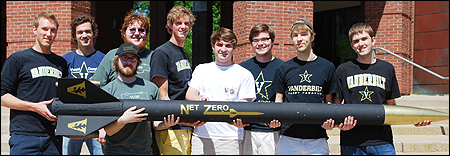Rockets flew Sunday over Bragg Farms in Toney, Ala. during NASA’s annual University Student Launch Competition, and while the Aerospace Club won Best Payload Design Award for the third straight year, a first-time award has given Vanderbilt some additional bragging rights.
A combined team from Vanderbilt Engineering’s Aerospace Club and Peabody’s Department of Teaching and Learning won a prestigious outreach award from NASA – the 2012 Educational Engagement Award – for inspiring school students in the study of rocketry and other science, technology, engineering and mathematics (STEM) related topics.
 The 2012 Vanderbilt Aerospace Club members: L-R, Brock Smethills, Ryan Thompson, Chris Lioi, Dexter Watkins, Paul Allen, Taylor Stevenson, Zach Smith, Thomas Hardy and Tyler Hannan. |
The outreach project was conducted as part of the year-long USLI competition. This year 42 university teams participated, up from eight in 2007. All scores from the USLI competition April 21-22 will be tallied and final results aren’t expected for about three weeks, but the Best Payload Award and the Educational Engagement Award position Vanderbilt to do well in the final tally.
Under the guidance of Amrutur Anilkumar, professor of the practice of mechanical engineering, and Heather Johnson, assistant professor of the practice of science education, the Vanderbilt team designed and executed a comprehensive educational program that reached out to select under-served middle schools in Nashville.
“The story begins with outreach efforts of the Aerospace Club,” Anilkumar said. “This is a required part of the NASA USLI program, and we wanted our outreach project to be of a more sustainable nature, with quantifiable results.”
When nine members – all mechanical engineering students – of Vanderbilt’s Aerospace Club partnered with the Peabody’s Department of Teaching and Learning to design lesson plans that would ignite youngsters’ interest in engineering, the solution was simple: Build bottle rockets.
A New Venture
Take ME to School was organized last semester as part of the secondary science teacher practicum experience. The engineering students worked with six Vanderbilt education students who teach science at area schools as part of their licensure requirements.
“The students designed a short, four-day rocketry unit to incorporate engineering design with content objectives as outlined in the Tennessee state standards, and the models produced by the Aerospace Club,” said Johnson. Michelle Cotterman, a Ph.D. student in the Department of Teaching and Learning, facilitated the cross-campus collaboration. The project consisted of a series of visits to three schools, Cora Howe Middle School, Wright Middle School and Bailey Middle School and about 500 students participated.
According to Anilkumar, “What truly sets apart this outreach effort from other efforts undertaken is its depth. While many teams attempted to reach a broad group of children and organize small, one-time events at many different schools, the approach taken by the Vanderbilt team has been to engage students in much more thorough and detailed activities.”
 Winners of school rocketry events visit Vanderbilt and spend the day with the outreach team hosts. (L-R) Vanderbilt students Taylor Stevenson, Chris Lioi, Zach Smith, Paul Allen, Tyler Hannan, Lauren Angotti, Meaghan Robertson, Michelle Cotterman, Jordan Nelson and Claire Bickel. |
Engineers from the Vanderbilt University Aerospace Club aided in the construction and operation of the demonstration and launch equipment, which was used to great effect by the educational team in teaching the scientific and engineering concepts, eventually leading up to the school bottle rocket launches.
Activities included discussions of key physics and engineering principles, such as Newton’s Laws of motion and the engineering design process, and several stages of construction of the bottle rockets. Groups of students launched their rockets on the last activity day and the altitudes were calculated based on the time the rockets spent airborne.
“Rigorous pre-and post-assessments and extensive analysis of the results were conducted and students from all schools showed marked improvement in most areas of assessment,” Johnson said. “This educational program has not only provided an enjoyable, interesting, and motivating experience for the children, but also has laid the foundation for future ventures in this spirit.”
The groups with the highest altitudes – one from each school – were awarded a trip to Vanderbilt University. They were treated to a tour of several engineering laboratories, workshops, project demonstrations and a lunch at the faculty club.
“It takes time, effort and care to invigorate a community of young minds the way our outreach team has done, and I believe the recognition of the team with this award represents an acknowledgement of the tremendous value of such a program,” said Cotterman, Peabody’s team leader.
“This is a new venture and it may lead to new ways for educators to incorporate engineering design processes into middle school curriculum,” said Anilkumar.
The New Framework for K-12 Science Education: Practices, Crosscutting Concepts, and Core Ideas (2011) calls for engineering practices to be embedded in science classrooms for all K-12 grade levels, Johnson said. “In my experience, middle school and elementary school teachers do this less often and need more support in bringing engineering into the classroom.”
Both Anilkumar and Johnson believe the collaboration between the engineering school and the school of education is unique. One thing is certain, the launch of Take ME to School has been a success, and it may be the start of a solid partnership between the School of Engineering and Peabody.